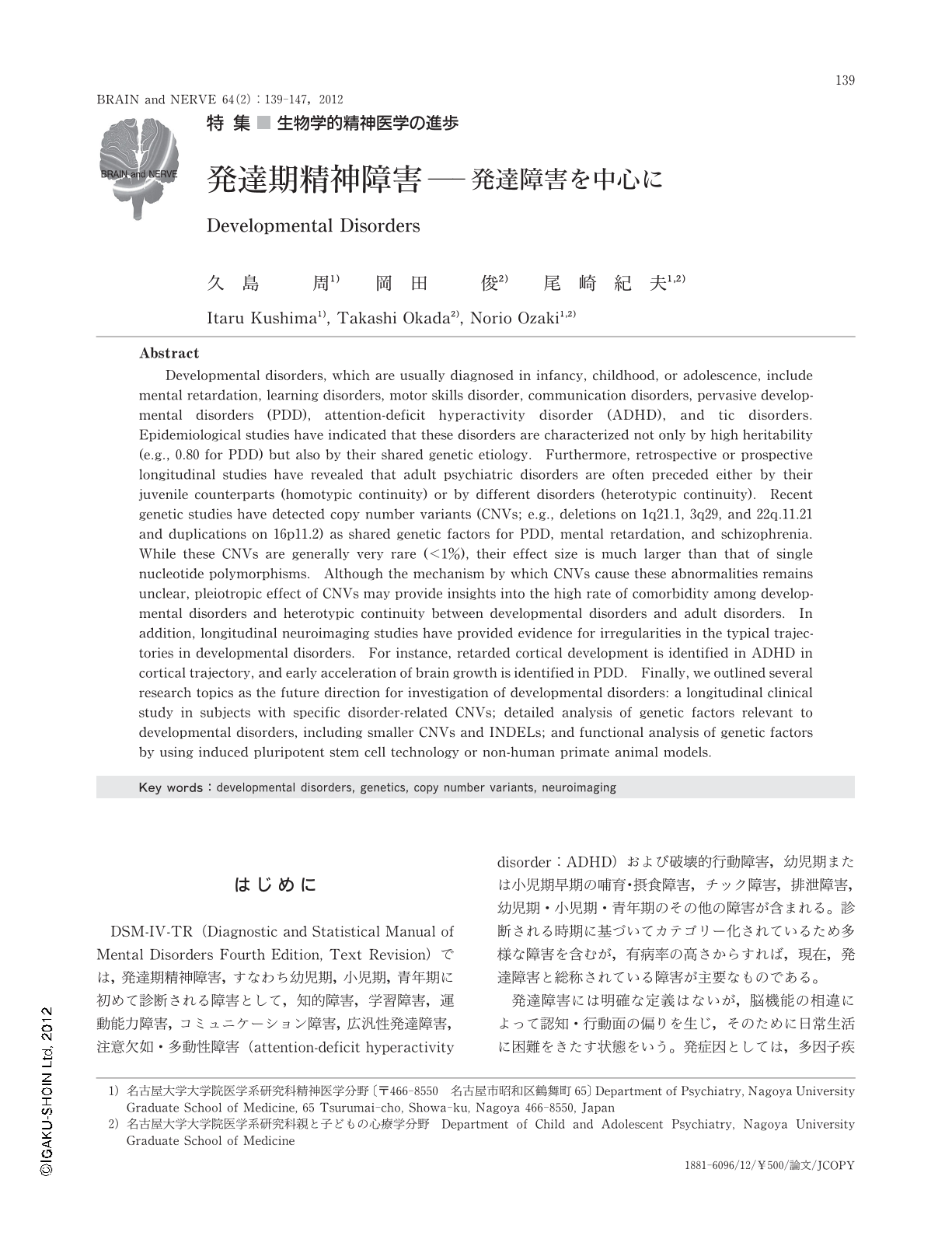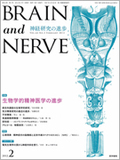Japanese
English
- 有料閲覧
- Abstract 文献概要
- 1ページ目 Look Inside
- 参考文献 Reference
はじめに
DSM-IV-TR(Diagnostic and Statistical Manual of Mental Disorders Fourth Edition, Text Revision)では,発達期精神障害,すなわち幼児期,小児期,青年期に初めて診断される障害として,知的障害,学習障害,運動能力障害,コミュニケーション障害,広汎性発達障害,注意欠如・多動性障害(attention-deficit hyperactivity disorder:ADHD)および破壊的行動障害,幼児期または小児期早期の哺育・摂食障害,チック障害,排泄障害,幼児期・小児期・青年期のその他の障害が含まれる。診断される時期に基づいてカテゴリー化されているため多様な障害を含むが,有病率の高さからすれば,現在,発達障害と総称されている障害が主要なものである。
発達障害には明確な定義はないが,脳機能の相違によって認知・行動面の偏りを生じ,そのために日常生活に困難をきたす状態をいう。発症因としては,多因子疾患の中では遺伝因子が比較的高いが,胎生期,周産期,出生後早期などの環境因子の関与も示されている。遺伝因子と環境因子の相互作用の分子基盤として,遺伝子のエピジェネティックな変化が発達障害の発症に寄与していることを示唆する知見も,近年報告されている。
本稿では,発達障害の診断とその病態上の位置づけについて述べたうえで,遺伝子研究,画像研究の最新の知見を展望し,今後の研究の方向性について論じることとする。
Abstract
Developmental disorders,which are usually diagnosed in infancy,childhood,or adolescence,include mental retardation,learning disorders,motor skills disorder,communication disorders,pervasive developmental disorders (PDD),attention-deficit hyperactivity disorder (ADHD),and tic disorders. Epidemiological studies have indicated that these disorders are characterized not only by high heritability (e.g.,0.80 for PDD) but also by their shared genetic etiology. Furthermore,retrospective or prospective longitudinal studies have revealed that adult psychiatric disorders are often preceded either by their juvenile counterparts (homotypic continuity) or by different disorders (heterotypic continuity). Recent genetic studies have detected copy number variants (CNVs; e.g.,deletions on 1q21.1,3q29,and 22q.11.21 and duplications on 16p11.2) as shared genetic factors for PDD,mental retardation,and schizophrenia. While these CNVs are generally very rare (<1%),their effect size is much larger than that of single nucleotide polymorphisms. Although the mechanism by which CNVs cause these abnormalities remains unclear,pleiotropic effect of CNVs may provide insights into the high rate of comorbidity among developmental disorders and heterotypic continuity between developmental disorders and adult disorders. In addition,longitudinal neuroimaging studies have provided evidence for irregularities in the typical trajectories in developmental disorders. For instance,retarded cortical development is identified in ADHD in cortical trajectory,and early acceleration of brain growth is identified in PDD. Finally,we outlined several research topics as the future direction for investigation of developmental disorders: a longitudinal clinical study in subjects with specific disorder-related CNVs; detailed analysis of genetic factors relevant to developmental disorders,including smaller CNVs and INDELs; and functional analysis of genetic factors by using induced pluripotent stem cell technology or non-human primate animal models.

Copyright © 2012, Igaku-Shoin Ltd. All rights reserved.


